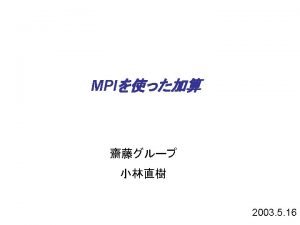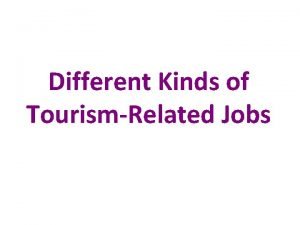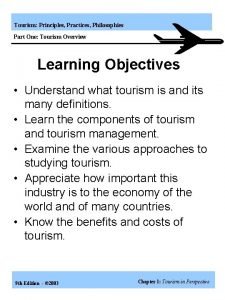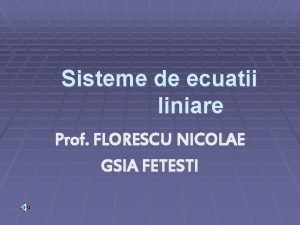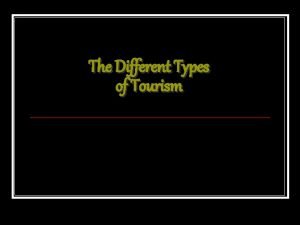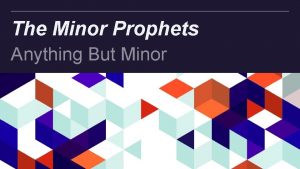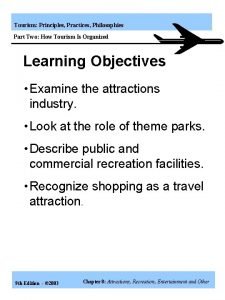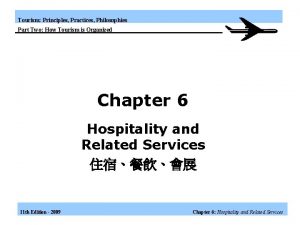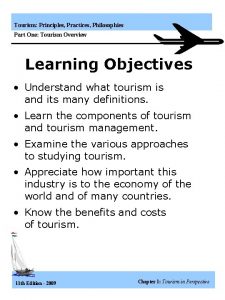Principles and Practices of Tourism TOUR 5001 Minor










- Slides: 10

Principles and Practices of Tourism TOUR 5001 Minor Assignment Topic 6 Why is interpretation used as a tool to manage the tourist experience? Sophie SWART

What is a “Tourism Experience”? 1. Defined as being affected by or gaining knowledge by observation or participation. 2. Is unique and meaningful to the individual ² and an escape from everyday life ³. 3. Tourists develop these experiences from their contacts with: Government bodies, host communities, travel agencies, etc. 4. Experiences start with trip planning and finish with trip evaluation post-travel.

The problem with defining tourism experiences 1. Tourism experiences are highly personal and are constantly changing, so it is difficult to provide a general definition. 2. They also differ from different countries and cultures.

Tourist satisfaction and tourism experiences 1. Positive tourist satisfaction = Positive tourism experiences. 2. But, satisfaction is only obtained when pre-existing expectations are exceeded. 3. Strong correlation between overall satisfaction and intention to recommend and repeat the experiences. 4. Therefore the aim for management is to increase tourist satisfaction.

What is interpretation? 1. “Providing information to visitors about the places that are in and encouraging them to appreciate and care for these places. ” 2. It “enhances the enjoyment of tourists by explaining symbolic meanings and facilitating changes in their attitudes and behaviours. ” 3. It can be indirect (signage, audio, literature, internet, etc. ) or direct (personal face-to-face visitor interaction). 4. Equally it can either be onsite or offsite.

Motivation for knowledge and the need for interpretation 1. Tourists seek certain satisfaction outcomes from their tourism experiences such as education and knowledge, and these can be defined as a motivation to travel. 2. Interpretation is the means to deliver this education and knowledge. 3. In simplified terms it can then be argued that tourists are motivated to learn, and this motivation coupled with appropriate interpretation adapted to their needs, results in them being more satisfied at the end of their visit, and hence having a better tourism experience.

Interpretation as a management tool 1. Visitor satisfaction (as a result of being exposed to interpretation programmes) can be used to measure management performance. 2. Interpretation effectiveness as a management tool is strengthened by a better understanding of the needs and wants of the target market. 3. Once understood, management can then design appropriate interpretative programmes to achieve management objectives.

Management benefits of interpretation 1. Economic Stability: It contributes to (sustainable) tourism as it enhances the quality of the experience for the tourist and encourages economic stability and sustainability. 1. Changed Values and Behaviours: a. b. It can thought provoke, create meaning and eventually change behaviour. It encourages the tourist to be further implicated, involved and satisfied, and more likely to spend more time at the exhibition, purchase something, return again, generate positive word of mouth, volunteer, etc. 2. Spread the Message: It can promote sustainability and environmental causes, by educating tourists on the impacts of visitor use, encourage appropriate behaviours and make visitors support the underlying philosophies of the site. 3. Provide Differentiation: It can provide a method to differentiate the tourism product from different tour operators, by tailoring the offer to different market segments, therefore attracting business.

Management implications 1. Quality interpretation is a key component in the development of a sustainable tourism industry, for visitors have the potential to spread the message “around the globe. ” 2. Collecting regular feedback from visitors ensures that effective management decisions can be made, rather than just relying on “gut feeling. ” 3. Feedback allows management to “design and deliver a memorable experiences likely to result in positive postconsumption reactions. ” 4. Interpretation remains an extremely powerful tool for management, but it needs to be understood and correctly applied to maximise its benefits.

References 1. 2. 3. www. merriam-webster. com accessed on 10 th March 1013 www. fr. slideshare. net/hillarypjenkins/interpretation-in-tourism accessed on 13 th March 2013 Aho, S. K. (2001). "Towards a general theory of touristic experiences: Modelling experience process in tourism" Tourism Review 56(3/4): 33 - 37. 4. Archer, D. and S. Wearing (2002). "Interpretation and marketing as management tools in national parks: Insights from Australia. " Journal of Leisure Property 2(1): 29. Camelis, C. and C. Maunier (2013). "Toward an identification of elements contributing to satisfaction with the tourism experience. " Journal of Vacation Marketing 19(1): 19 -39. Chappel, S. 2008, TOUR 5001 Study Guide, University of South Australia, Adelaide. Cutler, S. Q. and B. A. Carmichael (2010). "The dimensions of the tourist experience. " The Tourism and Leisure Experience: Consumer and Managerial Perspectives 44: 1. de Rojas, C. and C. Camarero (2008). "Visitors’ experience, mood and satisfaction in a heritage context: Evidence from an interpretation center. " Tourism Management 29(3): 525 -537. Ham, S. and B. Weiler (2007). "Isolating the role of on-site interpretation in a satisfying experience. " Journal of Interpretation Research 12(2): 5 -24. Ham, S. H. and B. Weiler (2002). Interpretation as the centrepiece of sustainable wildlife tourism. Sustainable tourism: a global perspective. R. Harris, Williams, P & Griffin T. Oxford, Butterworth-Heinemann: 9. Jennings, G. , et al. (2009). "Quality Tourism Experiences: Reviews, Reflections, Research Agendas. " Journal of Hospitality Marketing & Management 18(2 -3). Jennings, G. and N. Nickerson (2012). Quality tourism experiences, Routledge: 24 -44. Moscardo, G. (1998). "Interpretation and Sustainable Tourism. " The Journal of Tourism Studies 9(1). Moscardo, G 2006, "Is near enough good enough? Understanding and managing customer satisfaction with wildlife-based tourism experiences" CABI, Wallingford, UK. Rabotic, B 2010 'professional tourist guiding: the importance of interpretation for tourist experiences', Faculty of Tourism and Hospitality Management in Opatija. 20 th Biennial International Congress: New Trends in Tourism and Hotel Management, Opatija (Croatia), 06– 08. 05. 2010, [*VOLUME UNKOWN*], pp. 1157 - 1168 Stewart, E. J. , et al. (1998). "The “place” of interpretation: a new approach to the evaluation of interpretation. " Tourism Management 19(3): 257 -266. Williams, C. and J. Buswell (2003). The leisure and tourism experience. Wallingford, UK, CABI Publishing. 5. 6. 7. 8. 9. 10. 11. 12. 13. 14. 15. 16. 17.
 Mpi 5001
Mpi 5001 Minar arc
Minar arc Differentiate between a guide and an escort
Differentiate between a guide and an escort Tourism principles practices philosophies
Tourism principles practices philosophies Tour eiffel tours petronas shanghai world financial
Tour eiffel tours petronas shanghai world financial Bad world tour
Bad world tour Sistem de ecuatii cu 3 necunoscute
Sistem de ecuatii cu 3 necunoscute Mass tourism vs alternative tourism
Mass tourism vs alternative tourism Security program and policies principles and practices
Security program and policies principles and practices Security program and policies principles and practices
Security program and policies principles and practices Security program and policies principles and practices
Security program and policies principles and practices
